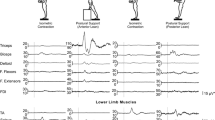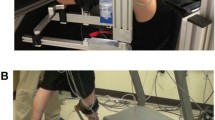Summary
Long latency responses to electrical stimulation of nerve trunks in upper and lower extremities were studied in 83 healthy subjects. The latency differences between the late responses, M2, and the segmental reflexes, M1, on the hand correlated with the height, confirming a transcortical reflex loop. Corresponding to the possible polysynaptic spinal origin of the late reflex response on the lower leg, there was no correlation with height. Therefore, it is not possible to calculate the intraspinal conduction time from long latency reflex examinations.
Similar content being viewed by others
References
Calancie B, Bawa P (1985) Firing patterns of human flexor carpi radialis motor units during the stretch reflex. J Neurophysiol 53:1179–1193
Chan CWY, Melvill Jones G, Kearney RE, Watt DGD (1979) The “late” electromyographic response to limb displacement in man. Electroencephalogr Clin Neurophysiol 46:173–181
Claus D (1986) Long Loop Reflexe — eine klinisch relevante Methode? Fortschr Neurol Psychiatr 54:35–41
Claus D, Lang C, Kotzian J (1985) Zur Beziehung zwischen Longloop-Reflexbefund und Topographie von Hirninfarkten. Z EEG-EMG 16:196–200
Conrad B, Aschoff JC (1977) Effects of voluntary isometric and isotonic activity on late transcortical reflex components in normal subjects and hemiparetic patients. Electroencephalogr Clin Neurophysiol 42:107–116
Darton K, Lippold OCJ, Shahani M, Shahani U (1985) Long-latency spinal reflexes in humans. J Neurophysiol 53:1604–1618
Deuschl G, Schenck E, Lücking CH (1985) Long-latency responses in human thenar muscles mediated by fast conducting muscle and cutaneous afferents. Neurosci Lett 55:361–366
Diener HC, Ackermann H, Dichgans J, Guschlbauer B (1985) Medium and long-latency responses to displacements of the ankle joint in patients with spinal and central lesions. Electroencephalogr Clin Neurophysiol 60:407–416
Dietz V, Quintern J, Berger W (1984) Corrective reactions to stumbling in man: functional significance of spinal and transcortical reflexes. Neurosci Lett 44:131–135
Eisen A, Burton K, Larsen A, Hoirch M, Calne D (1984) A new indirect method for measuring spinal conduction velocity in man. Electroencephalogr Clin Neurophysiol 59:204–213
Evarts EV, Vaughn WJ (1978) Intended arm movements in response to externally produced arm displacements in man. In: Desmedt JE (ed) Cerebral motor control in man: long loop mechanisms. Progress in clinical neurophysiology, vol 4. Karger, Basel, pp 178–192
Forssberg H (1985) Ontogeny of human locomotor control. I. Infant stepping, supported locomotion and transition to independent locomotion. Exp Brain Res 57:480–493
Hore J. Villis T (1984) A cerebellar — dependent efference copy mechanism for generating appropriate muscle responses to limb perturbations. In: Bloedel RJ, Dichgans J, Precht W (eds) Cerebellar functions. Springer, Berlin Heidelberg New York Tokyo, pp 24–35
Jenner JR, Stephens JA (1982) Cutaneous reflex responses and their central nervous pathway studied in man. J Physiol (Lond) 333:405–419
Lance JW (1984) Pyramidal and extrapyramidal disorders. In: Shahani BT (ed) Electromyography in CNS disorders: central EMG. Butterworth, Boston London, pp 1–18
Lee RG, Tatton WG (1975) Motor responses to sudden limb displacements in primates with specific CNS lesions and in human patients with motor system disorders. J Can Sci Neurol 2:285–293
Lenz FA, Tatton WG, Tasker RR (1983) Electromyographic response to displacement of different forelimb joints in the squirrel monkey. J Neurosci 3:783–794
Marsden CD, Merton PA, Morton HB (1976) Servo action in the human thumb. J Physiol (Lond) 257:1–44
Marsden CD, Rothwell JC, Day BL (1984) The stretch reflex: human spinal and long-loop reflexes. In: Shahani BT (ed) Electromyography in CNS disorders: central EMG. Butterworth, Boston London, pp 45–76
Matthews PBC (1984) Evidence from the use of vibration that the human long-latency stretch reflex depends upon spindle secondary afferents. J Physiol (Lond) 348:383–415
Matthews PBC (1984) Observations on the time course of the electromyographic response reflexly elicited by muscle vibration in man. J Physiol (Lond) 353:447–461
Meinck HM, Küster S, Benecke R, Conrad B (1985) The flexor reflex — influence of stimulus parameters on the reflex response. Electroencephalogr Clin Neurophysiol 61:287–298
Melvill Jones G, Watt DGD (1971) Observations on the control of stepping and hopping movements in man. J Physiol (Lond) 219:709–727
Noth J, Podoll K, Friedemann HH (1985) Long-loop reflexes in small hand muscles studied in normal subjects and in patients with Huntington's disease. Brain 108:65–80
Upton ARM, McComas AJ, Sica REP (1971) Potentiation of “late” responses evoked in muscles during effort. J Neurol Neurosurg Psychiatry 34:699–711
Wertheim Salomonson JKA (1914) 2. Verkürzungsreflexe. Neurol Centralbl 33:1180–1188
Wiesendanger M, Miles TS (1982) Ascending pathway of low-threshold muscle afferents to the cerebral cortex and its possible role in motor control. Physiol Rev 62:1234–1270
Author information
Authors and Affiliations
Rights and permissions
About this article
Cite this article
Claus, D., Jakob, S. The relationship between long latency responses and height. J Neurol 233, 271–273 (1986). https://doi.org/10.1007/BF00314158
Received:
Revised:
Accepted:
Issue Date:
DOI: https://doi.org/10.1007/BF00314158




